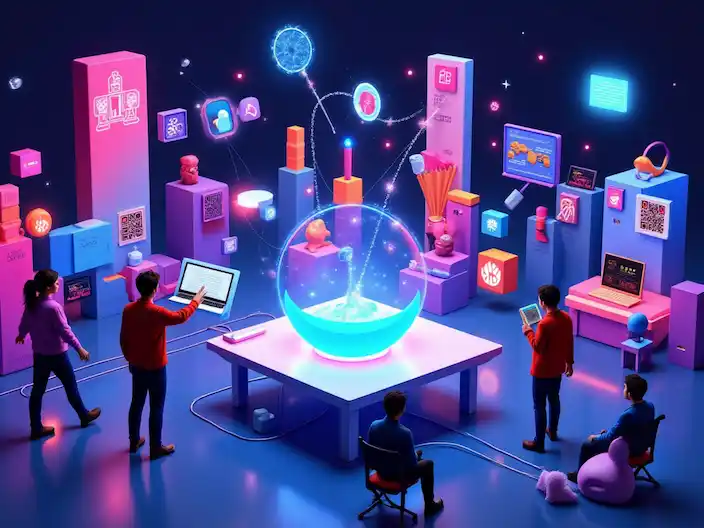Abstract
The integration of Artificial Intelligence (AI) into the Metaverse is redefining the landscape of digital collaboration and education. This paper explores the application of multifaceted AI in designing collaborative learning systems, with a particular focus on autonomous avatars as learning facilitators. It examines AI-driven interactions, personalization, and their implications for self-organized and adaptive education in immersive virtual environments. Drawing on insights from advanced AI models, large language models (LLMs), and autonomous agents, this research highlights both technological advancements and the educational strategies necessary to optimize collaborative learning experiences in the Metaverse.
1. Introduction
The emergence of the Metaverse as an expansive, interactive virtual platform has fundamentally transformed how humans interact with technology. This digital space, built on the integration of Virtual Reality (VR), Augmented Reality (AR), and simulated 3D environments, is recognized as the next generation of the internet. One of the most critical aspects of the Metaverse is its ability to provide adaptive and collaborative learning environments where AI acts as a key element to enable dynamic and personalized interactions.
Multifaceted AI in the Metaverse is emerging as a transformative force in digital education, professional collaborations, and social interactions. Leveraging large language models (LLMs), deep neural networks, and reinforcement learning algorithms, intelligent avatars can serve as instructors, collaborators, and learning facilitators in interactive environments. These avatars can manage complex conversations, identify individual learners’ needs, and even contribute to the development of users’ cognitive and analytical skills.
With advancements in generative AI technologies, virtual avatars have evolved from reactive to proactive entities. This means they not only respond to user inputs but can autonomously guide interactions, provide intelligent suggestions, and shape dynamic learning experiences. Furthermore, capabilities such as affective computing and social adaptation have enabled these avatars to engage in more human-like interactions, making the learning process more natural and effective.
1.1 The Need for Intelligent Learning Systems in the Metaverse
Traditional educational environments often follow a linear model with fixed curricula. This learning model, designed for large groups, fails to offer personalized experiences for individual learners. The Metaverse, combined with AI, removes these limitations by enabling collaborative, customized, and socially interactive learning experiences.
Key features of AI-based learning systems in the Metaverse include:
- Personalized Learning: AI-based avatars can identify individual user needs and adapt their learning paths based on previous progress and interactions.
- Multi-Agent Collaboration: Users can work collaboratively with autonomous avatars to solve problems, participate in scientific discussions, and engage in interactive simulations.
- Optimized Learning Experiences: Using reinforcement learning, intelligent avatars can continuously optimize learning experiences and provide immediate feedback.
- Integration of Cutting-Edge Technologies: Combining natural language processing (NLP), generative AI models, and user data analysis enables systems to offer intelligent educational recommendations.
1.2 Current Challenges and the Necessity of Research
Despite significant advancements in AI and the Metaverse, several challenges remain in developing collaborative learning systems powered by autonomous avatars:
- Scalability of AI Processes: LLMs require high computational power, necessitating resource optimization for implementation in large 3D environments.
- Emotional Understanding and Human Interaction: While AI avatars can process textual data, they still face limitations in interpreting user emotions and engaging in deep social interactions.
- Ethical and Privacy Considerations: Leveraging user data to enhance adaptive learning models requires strict privacy oversight and transparency in data processing.
- Enhancing Avatar Autonomy: Current models need improvement in handling complex interactions, solving abstract problems, and ensuring long-term learning stability.
1.3 Article Objectives
This paper aims to explore the role of multifaceted AI in the Metaverse and address the question of how autonomous avatars can function as learning facilitators in virtual education systems. The primary objectives of this research include:
- Examining AI capabilities in optimizing collaborative learning in virtual environments.
- Analyzing the impact of adaptive learning on user experience in the Metaverse.
- Identifying challenges and opportunities in developing autonomous avatars for digital education.
- Proposing a model for an intelligent learning system based on the Metaverse and AI.
By addressing these objectives, this research contributes to the advancement of interactive educational platforms and the development of effective strategies for learning in virtual environments.

2. AI-Powered Autonomous Avatars in the Metaverse
AI-powered autonomous avatars are among the most innovative aspects of the Metaverse, poised to revolutionize learning experiences, social interactions, and digital collaboration processes. Built on machine learning models, natural language processing (NLP), and reinforcement learning, these avatars can engage in intelligent interactions with human users and other digital agents while dynamically navigating virtual environments.
This section examines the features of autonomous avatars and their role in the Metaverse from three main perspectives:
- The evolution of smart avatar technology
- Cognitive and processing capabilities of AI-powered avatars
- Behavioral adaptability, social interaction, and independent decision-making
2.1. Evolution of Smart Avatar Technology
Advancements in AI technology have transformed the design and functionality of digital avatars from pre-programmed interactions to independent learning and decision-making. This evolution can be summarized in three main stages:
- First Generation (Simple, Pre-Programmed Avatars):
- These avatars were primarily rule-based, designed with predetermined responses.
- Their interactions were limited to a fixed set of responses with no capability for learning or behavior optimization.
- Examples include early video game characters and primitive virtual assistants.
- Second Generation (Semi-Intelligent Avatars with Limited Learning):
- These avatars leveraged NLP models and machine learning to understand human language.
- They could update information and improve interactions based on collected data.
- AI-driven chatbots like Siri, Alexa, and Google Assistant are examples of this generation.
- Third Generation (Autonomous Avatars with Cognitive and Independent Decision-Making Capabilities):
- These avatars utilize large language models (LLMs), reinforcement learning, and deep neural networks.
- They can comprehend emotions, behavioral contexts, and social nuances, providing tailored responses.
- In educational and professional environments, they serve as virtual instructors, interactive guides, and digital advisors.
This evolution has elevated autonomous avatars from reactive entities to strategic, intelligent companions capable of managing complex and diverse interactions in the Metaverse.

2.2. Cognitive and Processing Capabilities of AI-Powered Avatars
Smart avatars in the Metaverse showcase a range of cognitive and analytical capabilities, enabling them to create a natural and interactive experience. These capabilities include:
2.2.1. Natural Language Processing (NLP) and Verbal Interaction
- Utilizing large language models (LLMs) such as GPT and BERT to understand and generate complex text.
- Detecting hidden meanings, user intentions, and emotions in conversations.
- Offering real-time translation and multilingual processing for cross-cultural and cross-linguistic communication.
2.2.2. Adaptive Learning and Interaction Optimization
- Leveraging reinforcement learning (RL) to learn from past interactions and optimize responses.
- Employing transfer learning to apply prior knowledge to new situations.
- Recognizing individual learning styles and tailoring teaching strategies accordingly.
2.2.3. Reasoning and Problem-Solving
- Using autonomous decision-making algorithms to solve complex problems.
- Participating in scientific discussions, data analysis, and offering strategic suggestions.
- Leveraging graph neural networks (GNNs) to analyze relationships and social networks within the Metaverse.
2.3. Behavioral Adaptability, Social Interaction, and Independent Decision-Making
A prominent feature of autonomous avatars is their ability to perceive and adapt to the social environment of the Metaverse. These avatars can take on diverse social roles and function as collaborators, mentors, consultants, and analysts alongside human users.
2.3.1. Social Interaction and Emotional Recognition
- Identifying user emotions through analysis of text, voice, and body language.
- Managing group discussions, team meetings, and virtual training sessions using social interaction models.
- Providing motivational and supportive feedback to enhance user productivity.
2.3.2. Independent Decision-Making and Self-Organization
- Developing autonomous decision-making agents capable of creating personalized learning strategies.
- Contributing to group projects and offering data-driven suggestions.
- Adjusting interactions based on user goals and progress in learning.
2.3.3. Multi-Agent Collaboration and Virtual Environment Adaptation
- Coordinating between AI avatars and human users to create interactive collaborative spaces.
- Performing multiple roles in diverse scenarios (e.g., educational mentor, virtual tour guide, business consultant).
- Modifying digital body language, facial expressions, and tone to make interactions more natural.

2.4. Future of Autonomous Avatars in the Metaverse
Given the remarkable advancements in AI and the Metaverse, the future of autonomous avatars includes the following developments:
✅ Enhanced social and emotional intelligence to enable more human-like and natural interactions.
✅ Development of multimodal AI models to integrate audio, visual, text, and behavioral data.
✅ Increased autonomy in executing complex tasks, such as scientific data analysis, psychological counseling, and project management.
✅ Integration with blockchain and NFT technologies to create unique digital identities and enable virtual ownership in the Metaverse.
3. Collaborative Learning in the Metaverse
3.1. Transformation of Learning in the Metaverse: From Traditional Education to Collaborative Learning
Collaborative learning in the metaverse is a novel approach that leverages artificial intelligence (AI), augmented reality (AR), and virtual reality (VR) technologies to enable dynamic and interactive engagement in educational environments. Unlike traditional education models, which involve a one-way transfer of knowledge from teacher to student, collaborative learning prioritizes cooperation, interaction, and knowledge exchange among learners and intelligent agents.
The metaverse transforms learning from a passive process into a deep, multidimensional experience through immersive, interactive, and replicable environments. In this space, students, teachers, and AI avatars can participate in autonomous learning ecosystems, solving problems, engaging in practical experiences, and exploring discovery-based learning.
3.2. Key Features of Collaborative Learning in the Metaverse
In metaverse-based collaborative learning, several key elements distinguish it from traditional methods:
3.2.1 Real-time Interaction and Multi-agent Collaboration
- Students and autonomous avatars can collectively participate in group projects, discussions, and practical activities.
- Multi-agent AI technologies enable more dynamic and goal-oriented interactions.
- Learning environments can be interactive and adaptive, customizing educational content to meet learners’ needs.
3.2.2 Experiential Learning and Simulated Scenarios
- Students in the metaverse can engage with complex concepts through interactive simulations and role-playing.
- Fully immersive learning environments facilitate interaction with abstract concepts via data visualization and real-world experiences.
- For instance, medical students can practice surgeries in simulated environments without facing the limitations of the physical world.
3.2.3 Personalized and Adaptive Learning
- AI can assess learners’ comprehension levels, progress, and needs, tailoring educational content to each individual.
- AI avatars can act as personal guides, identifying students’ strengths and weaknesses and designing unique learning paths for them.
- Adaptive learning systems provide instant, customized feedback in real time.
3.2.4 The Role of AI in Facilitating Collaborative Learning
- Intelligent avatars can serve as coaches, guides, facilitators, and educational analysts.
- Natural Language Processing (NLP) models can optimize interactions between students and teachers and enhance learning experiences through sentiment analysis.
- AI-driven knowledge management systems can analyze information and refine educational content based on learning trends.
3.3. Models of Collaborative Learning in the Metaverse
3.3.1 Group Learning Based on Virtual Collaboration
- Learning groups are formed in interactive, virtual environments.
- Students collaborate on research projects and problem-solving tasks, guided by AI avatars.
- Examples include virtual scientific conferences, international seminars, and educational workshops within the metaverse.
3.3.2 Project-Based Learning (PBL)
- In this model, students execute a specific project within the metaverse, with AI avatars acting as mentors and facilitators.
- Projects can range from designing smart cities in the metaverse to simulating economic models or studying the impacts of climate change.
- AI avatars can gather necessary data and provide optimal recommendations for further steps.
3.3.3 Gamified and Interactive Learning
- Gamification elements, such as competition, scoring, and reward systems, make learning more engaging for students.
- Educational challenges in the metaverse can be presented through mission-based games, intellectual competitions, and competitive scenarios.
- For example, students might play the role of company managers in a metaverse economic simulation, testing business strategies.

3.4. Challenges and Opportunities of Collaborative Learning in the Metaverse
3.4.1 Key Challenges
🔹 Infrastructure limitations: High computational power is needed to run metaverse environments.
🔹 Ethical and privacy considerations: Protecting users’ personal data in interactive environments is crucial.
🔹 Access and digital inequality: Advanced equipment like VR headsets may not be accessible to everyone.
3.4.2 Opportunities and Benefits
✅ Enhanced international collaboration: Facilitates borderless learning and collaboration among students from different countries.
✅ Improved deep learning: Immersive environments enable a better understanding of abstract concepts.
✅ Development of social and cognitive skills: Encourages critical thinking, problem-solving, and teamwork in a digital setting.
Technical Challenges and Solutions
The integration of multi-faceted AI and autonomous avatars into the metaverse presents complex technical challenges, requiring innovative solutions and advanced infrastructure to optimize performance and deliver a stable user experience. These challenges include scalability, real-time processing, security and privacy, advanced social interactions, and energy optimization, which are explored below.
3.5. Scalability and Computational Needs in the Metaverse
Challenges:
- The metaverse requires extensive data processing, complex graphics, and real-time interactions, demanding powerful cloud servers, distributed computing, and advanced computational systems.
- Managing millions of concurrent users and complex interactions between intelligent avatars and human users imposes a heavy computational burden.
- Deep learning models and NLP for guiding autonomous avatars require advanced hardware, such as GPUs and NPUs.
Solutions:
✅ Distributed cloud computing: Utilizing hybrid cloud infrastructures (e.g., AWS, Google Cloud, Microsoft Azure) for simultaneous data processing and reduced latency.
✅ Edge computing: Shifting part of the processing to local devices (e.g., VR headsets) to reduce reliance on central servers.
✅ AI compression models: Employing techniques like pruning and quantization to reduce computational demands of deep learning models.
✅ Adaptive rendering optimization: Using dynamic rendering algorithms to automatically adjust graphic quality based on processing capabilities.
3.6. Security and Privacy Challenges in the Metaverse
Challenges:
- Users in the metaverse share vast amounts of personal information, social interactions, and biometric data, making it an attractive target for cyberattacks, hacking, and digital espionage.
- Authenticating users, protecting sensitive data, and preventing virtual fraud are significant technical concerns.
- Digital ethics issues arise from tracking users, identity theft, and unauthorized data collection.
Solutions:
✅ Blockchain technology: Implementing decentralized authentication, user verification, and digital ownership protection through NFTs and smart contracts.
✅ End-to-end encryption: Deploying end-to-end data encryption to safeguard personal information.
✅ Multi-factor authentication (MFA): Using biometric verification, hardware security keys, and one-time passwords to enhance security.
✅ AI for cybersecurity threat detection: Developing machine learning algorithms to detect suspicious behaviors, phishing attacks, and prevent digital identity fraud.

3.7. Advanced Social Interactions and Emotional Intelligence in Avatars
Challenges:
- Current limitations of AI in understanding human emotions, social behaviors, and non-verbal interactions hinder effective communication.
- Autonomous avatars must comprehend body language, facial expressions, voice tone, and user emotions to establish meaningful connections in the metaverse.
- The lack of empathy and natural interaction in virtual avatars may reduce the effectiveness and appeal of digital collaboration and learning.
Solutions:
✅ Enhanced emotion processing: Developing multimodal AI models that process visual, auditory, and textual inputs simultaneously.
✅ Cognitive neural networks: Employing affective computing algorithms to recognize user emotions and adapt avatar interactions accordingly.
✅ Optimizing avatar social interactions: Using social reinforcement learning algorithms to generate more natural and human-like responses.
3.8. Delayed Data Processing and the Need for Real-Time Interaction
Challenge:
- To maintain a sense of immersion in the metaverse, interactions must occur in real-time without any delays.
- Simultaneous processing of thousands of user interactions and intelligent avatars imposes a significant computational load on central servers.
- Latency in data transmission and reception can disrupt the user experience and interrupt interactions.
Solutions:
✅ Optimizing Content Delivery Networks (CDN): Using geographically distributed servers to minimize the distance between users and data centers.
✅ Low-Latency Communication Protocols: Leveraging 5G and advanced wireless networks to transmit data with minimal delays.
✅ Compressed AI Models: Developing lightweight algorithms for faster data processing without compromising interaction quality.
3.9. Optimizing Energy Consumption and Environmental Sustainability
Challenge:
- Running the metaverse and AI at scale requires high energy consumption and resource-intensive hardware infrastructure.
- Increased use of cloud data centers and heavy machine learning processes has significant environmental impacts.
- Balancing high performance with reduced energy consumption is a key challenge in developing a sustainable metaverse.
Solutions:
✅ Green Data Centers: Developing energy-efficient data centers powered by renewable energy sources.
✅ Efficient AI Processing: Utilizing low-power AI algorithms to reduce computational costs.
✅ Optimized Graphics Hardware: Advancing low-power neural processing units (NPUs) and energy-efficient GPUs.

4. Future Paths and Applications (Extended Version)
With continuous advancements in AI, machine learning (ML), the metaverse, and digital interactions, autonomous avatars and intelligent systems are expected to play a broader role in education, business, research, and social interactions. Emerging technologies will introduce novel solutions to enhance user experiences in the metaverse, creating unparalleled opportunities for learning, work, and global connectivity.
This section explores the future applications of intelligent avatars in the metaverse and discusses developmental prospects for this technology.
4.1. The Future of Learning and Education in the Metaverse
4.1.1. Virtual Universities and AI-Based Education
- Metaverse universities will emerge as fully interactive educational environments where students can attend immersive 3D classes.
- Virtual professors and AI-powered avatars will serve as adaptive learning guides using natural language processing (NLP) models.
- Personalized learning systems will enable learners to follow tailored paths based on their knowledge levels and learning speeds.
4.1.2. Practical Skills Training Through Metaverse Simulations
✅ Surgeons and doctors can simulate surgical operations in VR environments to develop their skills in a risk-free, cost-effective setting.
✅ Architecture and engineering students can design and test building models in 3D environments.
✅ Smart sports trainers can use physical data analysis in the metaverse to offer personalized training programs.
4.2. AI in Scientific Research and Innovation
4.2.1. Virtual Laboratories and Interdisciplinary Research
- The metaverse allows researchers to conduct scientific experiments in precise, simulated environments.
- Intelligent avatars will act as research assistants, contributing to data analysis, scientific simulations, and experiments.
- Biology, medicine, physics, and chemistry research can use metaverse-based models to test theories and optimize scientific models.
4.2.2. Social Research and Behavioral Analysis in the Metaverse
✅ Social scientists can use population simulation models to study human behavior, social policies, and the impact of emerging technologies on societies.
✅ Psychological and cognitive analyses can leverage AI-equipped avatars to study human interaction models in virtual environments.
✅ AI-based decision-making models provide deeper insights into economic, cultural, and social data analysis.
4.3. AI in Business and the Digital Economy
4.3.1. Virtual Markets and the Metaverse Economy
- The metaverse is evolving into a vast global marketplace where users can buy and sell digital assets (NFTs), virtual products, and blockchain-based services.
- Smart e-commerce systems will provide personalized shopping recommendations based on user data analysis.
- AI-powered business consultants can propose marketing and financial strategies to companies based on real-time data.
4.3.2. Virtual Workspaces and Business Automation
✅ Virtual offices equipped with AI facilitate business meetings, international conferences, and multinational collaborations in 3D digital environments.
✅ Intelligent robots and digital avatars can function as project managers, data analysts, and customer service experts.
✅ Robotic process automation (RPA) powered by AI will automate routine office tasks intelligently and efficiently.

4.4. The Role of AI in Developing Social Interactions and Digital Culture
4.4.1. The Metaverse as a Platform for Advanced Social Interactions
- Users can leverage intelligent avatars for social interactions, education, entertainment, and international communication.
- Metaverse social networks equipped with emotional AI will enable more human-like and natural interactions.
- Digital cultural and artistic events in the metaverse will feature avatars of famous artists, writers, and scientists.
4.4.2. AI’s Role in Cultural Education and Linguistics
✅ Users can learn different languages in simulated environments by directly interacting with native-language avatars.
✅ Digital museums and metaverse cultural spaces will enable scientific and historical tours from anywhere in the world without physical travel.
✅ Art and music education in the metaverse will become more interactive and engaging with virtual instructors and professional simulations.
4.5. AI in Digital Health and Metaverse-Based Medicine
4.5.1. Virtual Clinics and Metaverse-Based Telemedicine
- Hospitals and clinics can enhance remote healthcare services using AI.
- Physicians can conduct consultations and disease diagnoses in virtual environments using intelligent avatars.
- Patients will be able to experience 3D therapy plans, physiotherapy, and medical consultations.
4.5.2. Mental Health and Lifestyle Improvement Through AI
✅ AI-powered avatars will act as digital psychological counselors, helping patients manage stress and improve mental health.
✅ Medical data analysis systems will predict disease risks based on users’ personal health data.
✅ Users can rely on AI-based personal trainers for fitness programs and healthy lifestyle guidance.
5. Conclusion
The multifaceted transformation brought about by the metaverse and AI will not only fundamentally change educational, research, social, and economic trends but also pave new pathways for human interactions and digital experiences. Among these advancements, ALFANOVA Metaverse, leveraging innovative technologies, intelligent avatars, and collaborative learning systems, plays a key role in creating a dynamic and advanced digital ecosystem.
ALFANOVA not only functions as an intelligent educational and commercial environment but also offers a platform where users, students, researchers, and professionals can engage in complex interpersonal interactions, immersive educational experiences, and global collaborations.
5.1. ALFANOVA Metaverse: A Platform for Future Building and Digital Transformation
As one of the pioneers in creating AI-driven educational and commercial digital spaces, ALFANOVA Metaverse plays a significant role in advancing educational, research, and economic goals. This platform offers unparalleled opportunities for collaborative learning, hosting international conferences, business and medical simulations, and even conducting group projects in immersive 3D virtual environments. By utilizing AI-powered avatars and adaptive learning systems, ALFANOVA enables users to experience personalized, dynamic, and interactive learning.
5.2. ALFANOVA Metaverse and Transformations in Education and Learning
✅ ALFANOVA, as a metaverse-based educational environment, introduces a revolution in teaching and learning methods with features like autonomous avatars and interactive learning systems.
✅ Students, teachers, and professionals can collaborate in a fully immersive 3D space, enhancing their skills through simulated projects, educational games, and virtual experiments.
✅ With advanced AI models, data analysis, and optimized learning pathways, ALFANOVA significantly personalizes educational experiences, enabling users to delve deeper into the learning process.
5.3. Applications of ALFANOVA Metaverse in Business and the Digital Economy
✅ ALFANOVA is creating new economic opportunities through virtual marketplaces, digital transactions, and blockchain-based business prospects.
✅ This platform offers virtual commercial hubs for hosting meetings, conferences, and international business interactions, where AI-powered avatars can act as project managers, data analysts, and strategic consultants.
✅ Leveraging AI and blockchain, ALFANOVA provides a secure and efficient environment for digital trade, the buying and selling of virtual products, and offering services based on innovative technologies.
5.4. Transformation in Research and Scientific Innovations with ALFANOVA Metaverse
✅ ALFANOVA provides a suitable platform for researchers and scientists to conduct their studies in precise, secure simulated environments and interactively analyze complex scientific data.
✅ AI avatars in ALFANOVA can act as research assistants and scientific advisors in interdisciplinary research and innovation processes.
✅ International research, especially in fields like social sciences, medicine, biology, and technology, can gain momentum through global collaboration and access to advanced digital tools.
5.5. Technical Challenges and Solutions in ALFANOVA Metaverse
✅ ALFANOVA addresses challenges like scalability, security, data processing delays, and resource management through advanced solutions such as distributed cloud processing, edge computing, and compressed AI algorithms.
✅ User data security in ALFANOVA is ensured through advanced encryption, multi-factor authentication systems, and blockchain utilization.
✅ Using green data centers and low-power algorithms in ALFANOVA contributes to reducing energy consumption and achieving environmental sustainability.
5.6. Future Vision and ALFANOVA’s Role in the Digital World
✅ As a pioneer in metaverse technologies, AI, and blockchain, ALFANOVA will play an unparalleled role in the digital future.
✅ In the future, ALFANOVA will evolve into an inclusive, global environment where learning, research, business, and social interactions are seamlessly integrated with advanced technologies.
✅ ALFANOVA can become one of the key platforms for education, innovation, commerce, and enhancing the quality of human life in the digital world.
5.7. Final Conclusion: ALFANOVA Metaverse and an Advanced Digital Future
🔹 By leveraging advanced AI, metaverse, and blockchain technologies, ALFANOVA has emerged as a leading platform in education, business, research, and social interactions.
🔹 With the expansion of these technologies in the coming years, ALFANOVA can play a vital role in global transformations, offering a smarter, more efficient, and personalized digital world.
🔹 Providing a platform for multifaceted AI-driven interactions, ALFANOVA will ultimately become a key player in the future of educational, economic, and social transformations.
In conclusion, ALFANOVA is not just a technology but a digital future-maker, revolutionizing how people learn, work, communicate, and interact.
Table of Contents
Toggle

